Global House Contents
(1) Welcome Zone
The history of the universe, from the birth of space to the present, will be introduced in a screen presentation. The zone has been set up to stimulate interest in the exhibits and other showings.
(2) Laser Dream Theater (Blue Hall)
A laser projection system using state-of-the-art technology will deliver a novel screen experience on a 2,005-inch seamless screen (50 meters by 10 meters). This revolutionary theater boasts dynamic 11-channel sound, vivid color reproduction capabilities only possible with lasers, and a super-definition, super-resolution giant screen, making viewers really feel as if they are there.
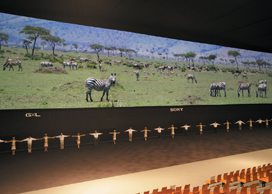
“2005: Voyage Around the Earth” (tentative name) (Video contents)
The human race came into being on Earth about seven million years ago and has rapidly increased in number to the present. What kind of future awaits us? To answer this, a dispassionate analysis of the situation today, at the beginning of the twenty-first century, is necessary. At the Laser Dream Theater, various data will be introduced to throw light on the present state of the Earth and humankind. An assessment of the overall health and welfare of the human race at the start of the twenty-first century will be conveyed in a stunningly vivid color experience.
(3) Prologue Zone (Orange Hall)
Visitors can verify their understanding of “Nature's Wisdom” acquired through individual displays at the Prologue Zone by receiving messages from their global navigators.
(4) Super High-Vision Theater (Orange Hall)
The world's first super high-definition image system, which can handle 16 times more information in a single screen than high vision, is featured here. Viewers can experience the beauty of the Earth on a 600-inch screen and 22.2 channels of three-dimensional acoustics. Two works will be shown at the Super High-Vision Theater, one during the first half of the Expo and the other during the second half.
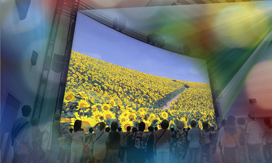
The first video, A Hymn to Life, is a document of the workings of people and other living things on the Earth. The panoramic scenes of nature that permeate the big screen make viewers feel as if they are actually there, and the super-resolution screen vividly recreates such details as the expressions and movements of small living things and individual petals of flowers.
The second work is a visual poem that unveils the beauty of the Earth through an emphasis on color. The green emanating from trees in early summer, the red tones of autumn leaves, the white of the snow that glistens in a mountain village with traditional thatched-roof houses are displayed here in their stunning beauty. The work vividly reproduces the multifold colors of the sun's rays as they are woven into the land while portraying the change of seasons in Japan.
(5) Global Street (Orange Hall)
Here, the most recent results of research into the relationship between life before the human race appeared on the Earth and the environment will be introduced. The research includes discoveries that overturn established theories of evolution and have led to new theories on environmental change.
(6) Global Showcase (Orange Hall)
Under the theme of “human creativity,” the results of recent research into the history of humankind and the environment will be introduced in six project stages. (Please refer to the attached materials.)
1. “The day humans were born”(Tentative Name)
The answer to such questions as “When and where did people come into existence?” “When did they become able to think creatively and abstractly?” and “How were these abilities acquired?” will be probed.
- Model of the excavated Toumai skull
- Model of the upper half of the Toumai body
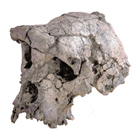
Model of the excavated Toumai skull
2. “The day mammoths died”(Tentative Name)
Did mammoths disappear from the Earth because they were hunted into extinction by people, who used their power to think to survive environmental changes? Or were they simply unable to adapt to changes in the global environment, such as warmer temperatures? An attempt will be made here to unravel the mystery of the mammoth's extinction.
- Model of the Yukagir Mammoth
3. “The day cities were built”(Tentative Name)
The birth of cities, built upon ideas of making the living environment more comfortable, the impact cities have on the environment, and the process by which the wisdom of urban civilizations transcended cultural exchanges between East and West and spread across the world will be explored.
- An announcement of the specific items to be exhibited is scheduled to be made in February.
4. “The day dreams came true”(Tentative Name)
An examination of the origins of the science and technology that underpin contemporary society will be made to understand how technological innovations spring from human creativity, the impact these innovations have, and the recent attempts to uncover new possibilities for the coexistence of people and the global environment.
- Model of James Watt's steam engine
- Difference engine
- The first DNA model made by James Watson and Francis Crick
5. “The day humans saw the earth from space” (Tentative Name)
The knowledge we have of space, which has shown us how rare and unique Earth is as a planet that is able to support life, and the results of recent research into the origins and history of humankind's fascination with space will be shown here.
Agreement has been reached with the United States Pavilion and NASA for their cooperation in providing exhibition items and visitor and other services. The United States Pavilion has agreed, for example, to make available images taken from the Cassini Saturn probe for the mission model display. In the coming weeks, further discussions are scheduled to be carried out on the specific areas for cooperation.
- Isaac Newton's telescope
- Nebra astronomical observatory
- Model of the lunar probe Selene
- Lunar rocks
- Footprints on the moon's surface
- Apollo space suits
- Mars rover simulator (probe model)
- Model of the asteroid explorer Hayabusa
- Model of the outer planet mission Voyager
- Voyager disc, a recording of sounds from Earth carried on the Voyager I and II missions
- Model of the Cassini Saturn probe
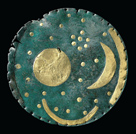
Nebra astronomical observatory
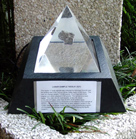
Lunar rocks
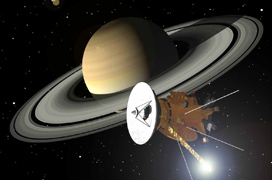
Model of the Cassini Saturn probe
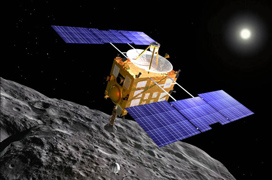
Model of the asteroid explorer Hayabusa
6. “The day that future began”(Tentative Name)
Creativity is the key to the future of the Earth and life. Efforts to realize a future grounded on conceptions and consideration are introduced.
- Konotori project

Konotori project
7. Global Studio (Orange Hall)
Various information on EXPO 2005 will be transmitted from the Global Studio to the rest of the world.
8. Daily Global (Orange Hall)
Junior correspondents recruited from elementary and middle schools in Japan will report on events at EXPO 2005 and edit a daily at newspaper production workshops. A total of 6,000 students from 61 schools in 35 municipalities will take part. The Daily Global will be a cooperative effort of the Ministry of Education, Culture, Sports, Science, and Technology and municipal boards of educations.
9. Mammoth Laboratory
The recent discovery of frozen mammoth remains in Siberia is not unrelated to global warming. The rise in temperature is causing Siberia's permafrost to melt, and specimens of the mammoths once locked into the frozen earth are surfacing as a result. If the frozen earth continues to melt, we will likely lose many of the precious resources that survived tens of thousands of years.
The Mammoth Excavation and Exhibition Project has been undertaken in the realization that the Yukagir Mammoth is a valuable resource, that this may be our last change to study it, and that by unearthing and researching it we may be able to unravel the mystery of the environment and life.
At the Mammoth Laboratory, the Yukagir Mammoth discovered and excavated in the Republic of Sakha in Russia will be displayed in its frozen form along with recent research findings as part of a joint Japanese-Russian academic research project.


